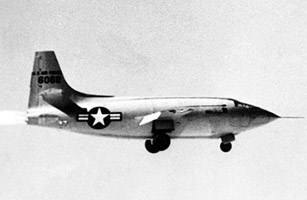
Yeager's fateful flight was top secret for several months.
Oct. 14, 1947
Chuck Yeager's two cracked ribs hurt like hell, but he was darned if a little tumble from a horse in the Mojave Desert was going to stop him from breaking the sound barrier. The U.S. Air Force was counting on him. It was his ninth flight in the experimental rocket plane XS-1, each one having edged closer to Mach 1, the never crossed barrier past which man would fly faster than the speed of sound. It was dangerous, he knew. A British test pilot had been blown to bits going Mach 0.94. The crew at Murdoc Air Base in California, not knowing the extent of Yeager's injuries, sent him off with a jolly "Hi-yo, Silver!"
Climbing painfully down into the XS-1 as it lay in the airborne belly of the huge mother ship, a B-29, Yeager snapped the cover shut using a sawed-off broom. At 20,000 ft., he dropped out of the bomb bay with a jolt. With all four rockets firing, the plane started shaking violently. The Mach needle edged up past 0.965, and then it went off the scale. Yeager was thunderstruck.
He was flying supersonic, and "it was as smooth as a baby's bottom: Grandma could be sitting up there sipping lemonade," he said later. He half didn't believe it—until the tracking crew ran up and reported hearing the world's first sonic boom, a sound that marked the end of the Wright Brothers' era and the beginning of the age of the astronauts, taking humankind into outer space. His XS-1 had accelerated to Mach 1.06, or 700 m.p.h. That night Yeager fixed his buddies a pitcher of martinis to celebrate. But the world would have to wait to learn of Yeager's feat. It was all top secret until Aviation Week broke the story in December. The government wouldn't come around to confirming it had happened until May 1948.